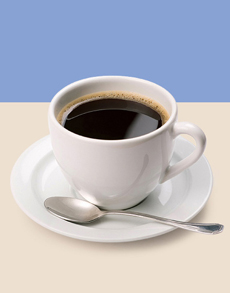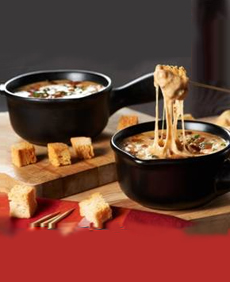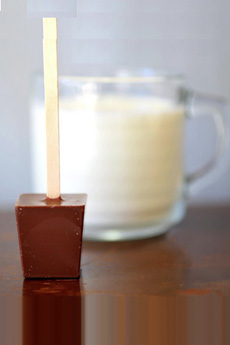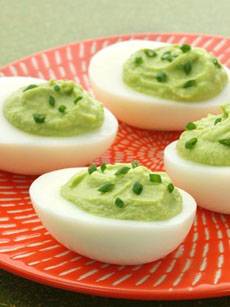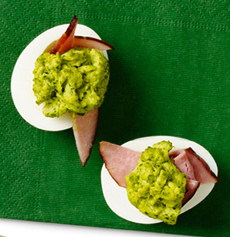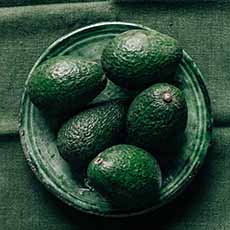|
March 8th is National Peanut Cluster Day. There is no documentation on the first appearance of the peanut cluster, but we know a few things, and below the peanut cluster history is an easy recipe to make your own. You’ll be delighted to bite into one with a cup of coffee, bring some as a hostess gift, or dig into your stash when you have a chocolate attack.
Make your own peanut clusters: an easy recipe is below.
PEANUT CLUSTER HISTORY
Peanuts. Peanuts, which originated in South America, were brought to West Africa by Portuguese and Spanish traders. Peanuts became a staple crop for West Africans, and came to the Southern U.S. with the slave trade around the late 1600s.
Chocolate. After some 3,300 years as a beverage, the first solid chocolate began to appear in Europe around 1840.
Chocolate With Fruits & Nuts. The first pressed chocolate tablets, pastilles, and figures were produced in Belgium. The chocolate was also used by confectioners to enrobe nuts and fruits. See our history of chocolate timeline.
Peanut Clusters. We can deduce that sometime after that, American confectioners began to make similar confections, including enrobed peanut clusters. Previously peanut clusters without a chocolate coating were held together with caramel or honey.
Automation. Jumping ahead to the 1930s, American inventor Elmo Lanzi patented a Chocolate Peanut Cluster Dipping Machine, automating the slow process of hand-enrobing. “Think of turning out 450 pounds of luscious, attractive Chocolate Peanut Clusters,” the advertisement trumpets.
Turtles. One confectioner substituted pecans for peanuts in a caramel-nut confection and added four pecan halves as “feet” to the bottom of the oval-shaped candy. These became known as “turtles.”
|
|
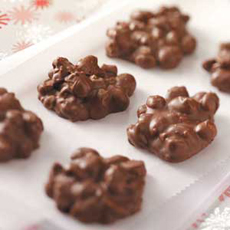
[1] Easy homemade peanut clusters. The recipe is below (photo © Taste Of Home).

[2] Don’t want to make your own? Buy these from Harry & David (photo © Harry & David).
|
|
|
|

[3] Peanuts (photo © The Nibble).

[4] We chopped some caramels into our nut clusters (photo © Hammonds Candies).
|
|
EASY PEANUT CLUSTERS RECIPE
This recipe (photo #1) was adapted from one submitted to Taste Of Home by Joy Dulaney of Highland Village, Texas. The total prep time is less than 30 minutes.
The original recipe called for milk chocolate confectionary coating*. You’ll get much better flavor from using a quality chocolate couverture (we used Guittard). You can also use real chocolate chips.
You can use dark, milk, or white chocolate, or split the recipe in half or thirds and make some of each.
The recipe also uses toffee bits, an easier recipe than making caramel peanut clusters. However, if you have caramels on hand, you can chop up an equivalent amount to substitute for the toffee bits. We took that route, and preferred the chewiness of the caramel.
If you don’t want peanuts, use any nut(s) you like. You can also add dried fruits: cranberries, raisins, etc.
Ingredients
1-1/2 pounds quality chocolate, coarsely chopped
1 jar (16 ounces) dry roasted peanuts
8 ounces toffee bits or chopped caramels
Optional garnish: coarse sea salt
Preparation
1. MELT chocolate in a double boiler or in a microwave-safe dish. Stir until smooth.
2. STIR in peanuts and toffee bits. Drop by rounded tablespoonfuls onto waxed paper-lined baking sheets. If desired, garnish with sea salt. Let stand until set.
3. Store in an airtight container. Yield: 5 dozen clusters.
|
Variations
You can substitute the toffee/caramel bits for more nutritious inclusions, or divide the eight ounces into equal portions of toffee/caramel and the following::
Dried fruit: Add raisins, dried cherries, blueberries or other favorite. We particularly enjoyed diced dried apricots.
Nuts: Add another type of nut, such as a peanut-almond mix. Or, if you don’t crave peanuts, substitute them completely.
Seeds: Seeds are as nutritious as nuts; some varieties even more so. Toss in some flax seeds, pepitas (shelled pumpkin seeds), or sesame seeds.
Spices: Make Mexican chocolate peanut clusters by adding a teaspoon of cinnamon and some chili heat.
_______________
*Confectionary coating, also called compound coating and decorator’s chocolate, is a chocolate-type product that substitutes vegetable oil for all or part of the cocoa butter. Along with sugar and cocoa powder, traditional chocolate production techniques are used to create a less expensive coating that does not require tempering, melts easily, and hardens quickly. In milk chocolate-flavored coatings, whey powders, whey derivatives, and dairy blends can be used instead of powdered milk. Products made with confectionary coating must be designated “chocolate-flavored,” to indicate that they are not “real” chocolate.
CHECK OUT WHAT’S HAPPENING ON OUR HOME PAGE, THENIBBLE.COM.
|
|




